
By Cheryl Anderson
“The designs are never completely symmetrical: the mirroring effect is only the illusion of repetition, a characteristic that, again, makes it exceptional.” Nadine Coleno
There they are, preliminary models of les carrés, spread out on the floor. Deliberation ensues. A decision has to be made regarding “balance and composition” about every carré model laying on the floor before them. I would love to be quietly sitting in the corner of the room to hear their discussion. What were their reasons behind the final choices? I wonder.

Observing the models, left to right, Robert Dumas, Jean Guerrand, Patrick Guerrand, Jean-Louis Dumas, Annie Beaumel, Liliane Dubroca, Bertrand Puech, and Camille Averous.
A design decision, for every item Hermès produces—les carrés, shawls, handbags and bijoux, to the window displays that grab your attention before you even go in the store at 24, rue Faubourg-Saint-Honoré. It’s the creative genius of the Hermès brand that whatever they produce works well for it’s intended use and at the same time is beautiful.

Pierre-Alexis Dumas and Bali Barret observing the models.
What’s in the “fridge?” You may not have heard that word associated with Hermès’ carrés. The “fridge” is where the carré designs are kept. The number of possibilities keeps growing. I read there are over 2000 designs in the Hermès archives. All of the designs find their way to the “fridge”—some with multiple “incarnations: bought, revised, titled, signed. Whenever a design is used, royalties are paid to these artists known as the mains (‘hands’), with their own unique style.”

L’Alphabet des Métiers, “…thousands of ways to earn a salary. This scarf presents a alphabetic selection of them-a little out of date, perhaps, but witnesses to a charming past.” Quote taken from a small Hermès publication. |
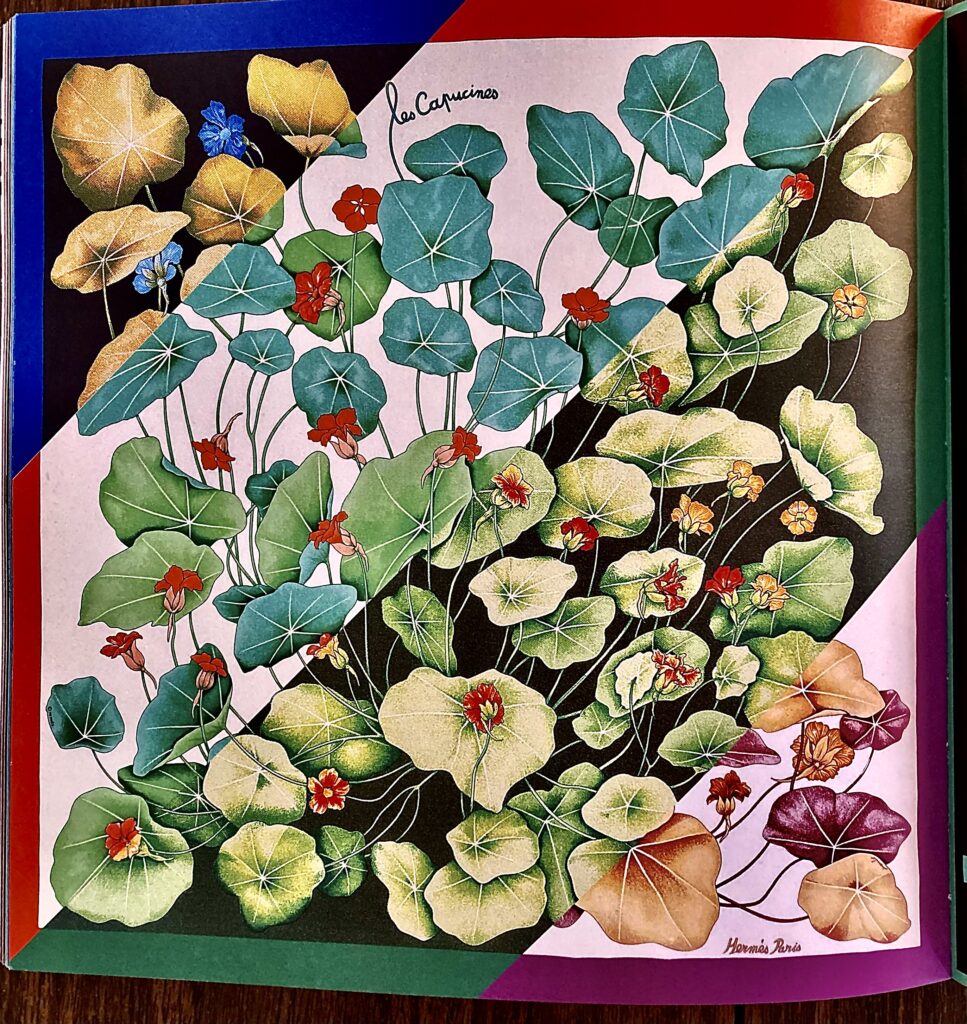
les Capucines, Antoine de Jacquelot, 2003. Four colorways of one of my favorite summer flowers. les Capucines, Antoine de Jacquelot, 2003. Four colorways of one of my favorite summer flowers. xxxxx |
Design themes considered are numerous. Among them are: bicycles, Les Bécanes, by Hugo Grygkar, keys, carriages and cars, “humor, with riders and horses swapping places, in the style of 19th-century England animal portraits.”, carré, Le Monde à l’envers is also by Hugo Grygkar. The Hermès carré designs sometime recall events in history or items from long ago—some designs are inspired by Émile’s vast collection. They depict nature and all its wonder and beauty, flowers, keys, seasons, wild animals, even squirrels, gardens, lots of equestrian themes, others are very modern, contemporary and minimalistic. There are motifs with regional appeal, and, sometimes, a bit of humor is the story. During the war, there were the motifs of riding and hunting. These themes were joined with new ideas and grew in numbers. An example, the regattas of Cannes, La Croisette, 1945. Every year, Hermès presents a new theme for their scarves.
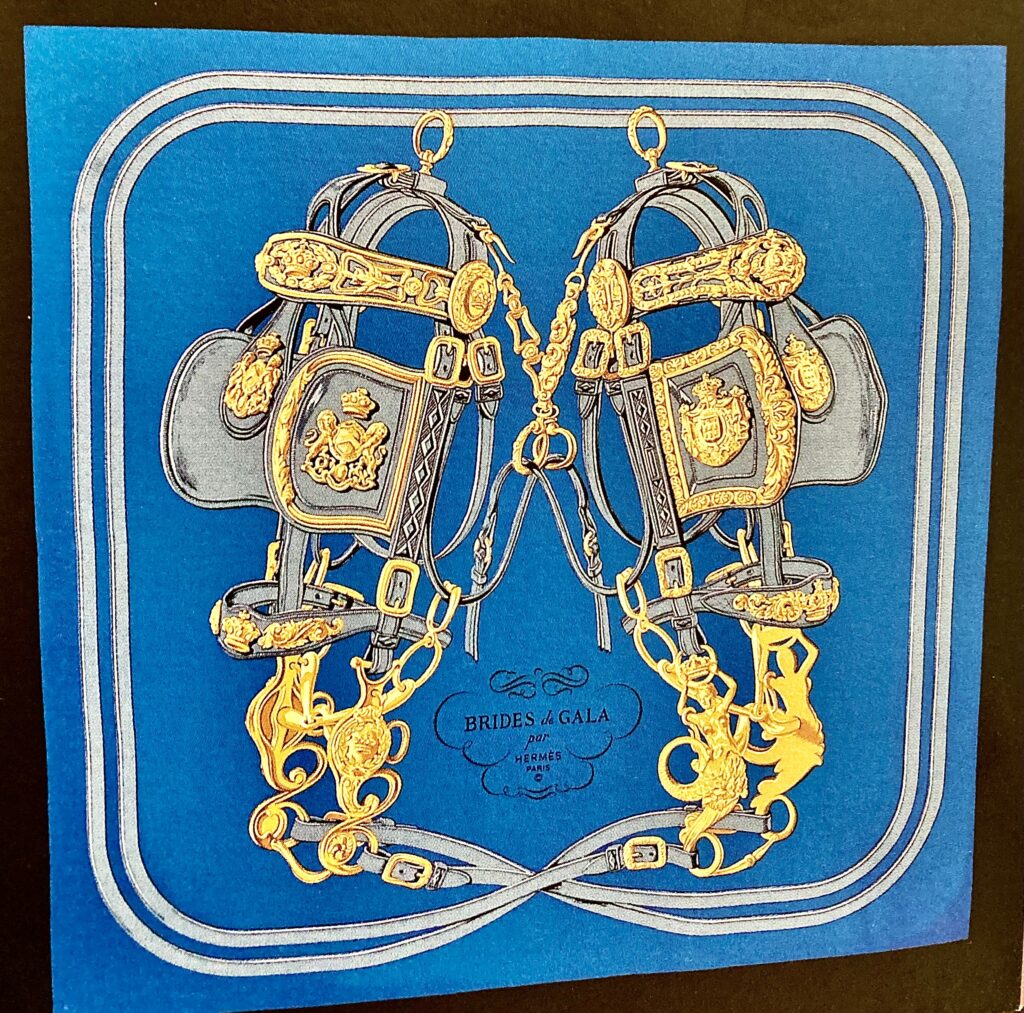
Harnais de Cour |
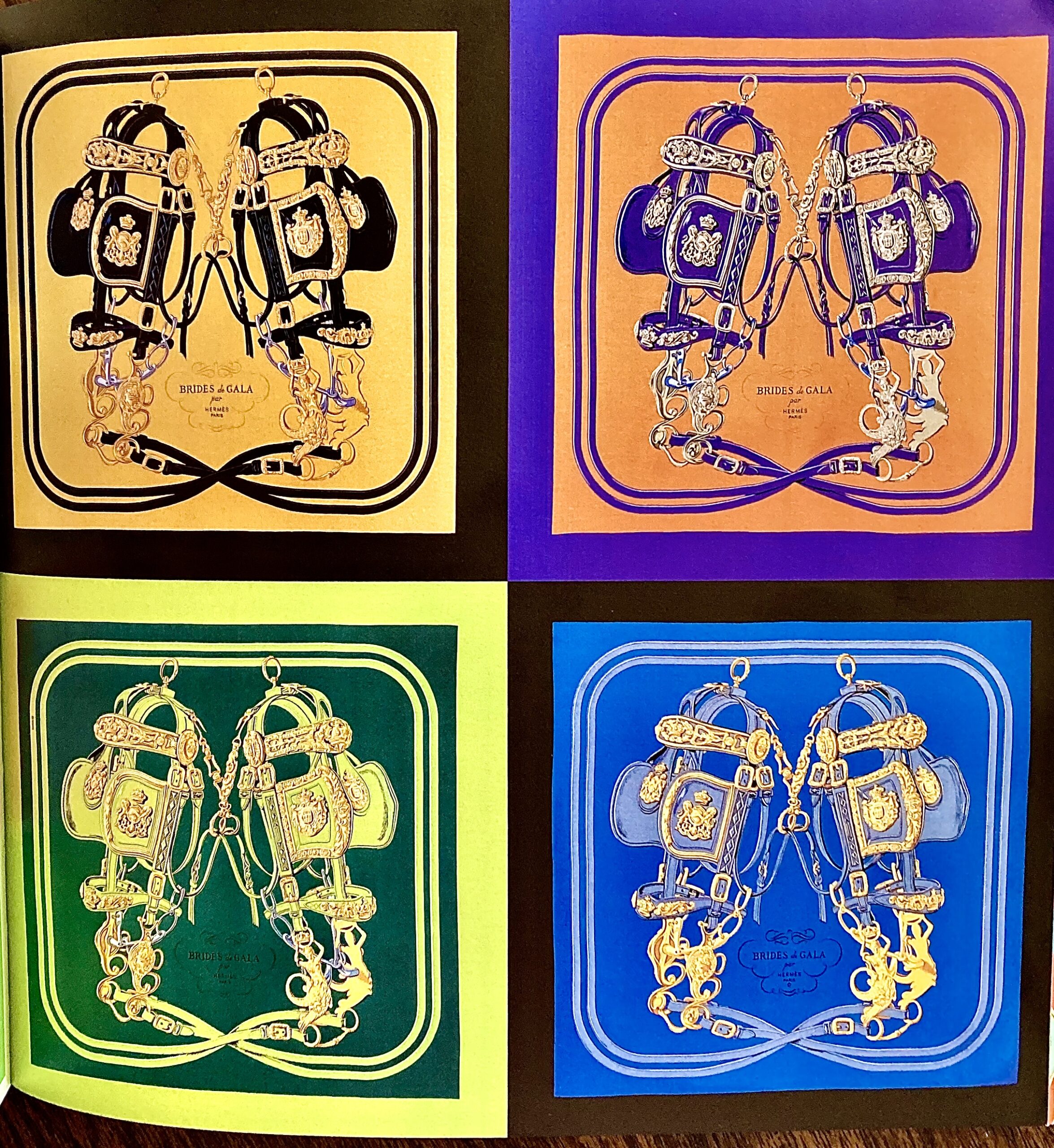 Brides de Gala in different color ways. Brides de Gala in different color ways.
|
Appealing to the “fantasies” of food-lovers, Robert Dumas designed a scarf named, À la gloire de la cuisine française (1945). “The idea is always the same at Hermès to make tradition live by shaking it up.”, Jean-Louis Dumas. An example of shaking it up was the shock held by some, even in the Hermès family, by promoting the idea of pairing silk scarves with jeans.
Two designers considered creators of the “classics” of the Hermès carrés are Hugo Grygkar and Philippe Ledoux.
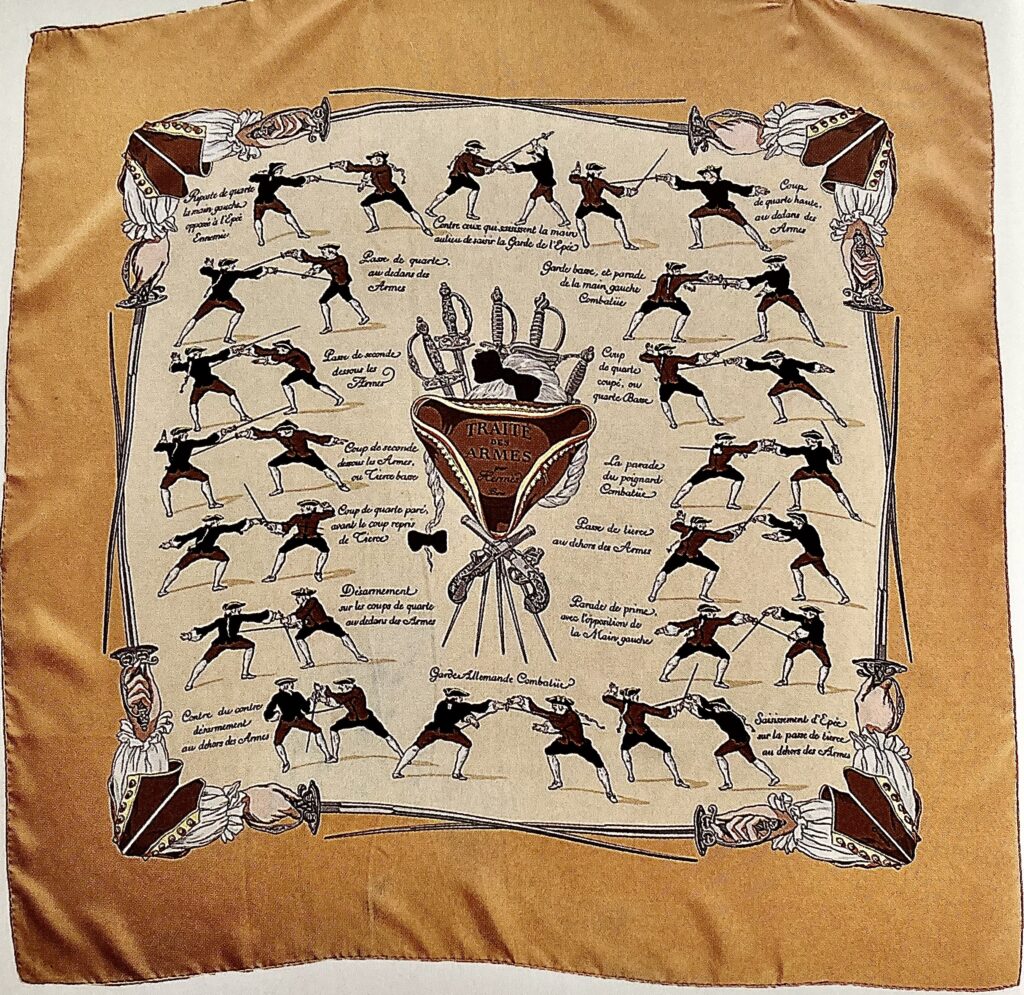
Traite des Armes, Hugo Grygkar, 1951
Hugo Grygkar was born in Germany to Czech parents in 1907 and moved to France in 1914. There he was an illustrator and commercial artist, including Vogue magazine—a prolific designer for the House of Hermès in the 1940s until his death in 1959. An avid reader claiming his reading influenced his designs for Hermès. He closely collaborated with Robert Dumas interpreting Dumas’ ideas. With Dumas’ ideas, keeping both of their obsession to detail in mind, Gryrgkar produced templates. As Nadine Coleno puts it, the two men possessed a “creative symbiosis that was the foundation of such successes as Brides de Gala, and Ex-Libris, (1937).” Always important to both men was accuracy of the detail, be it a rooster for his 1954 design, Combats de Coqs, or to see a real zebra skin for his, La Chase en Afrique.

Brides de Gala Love |
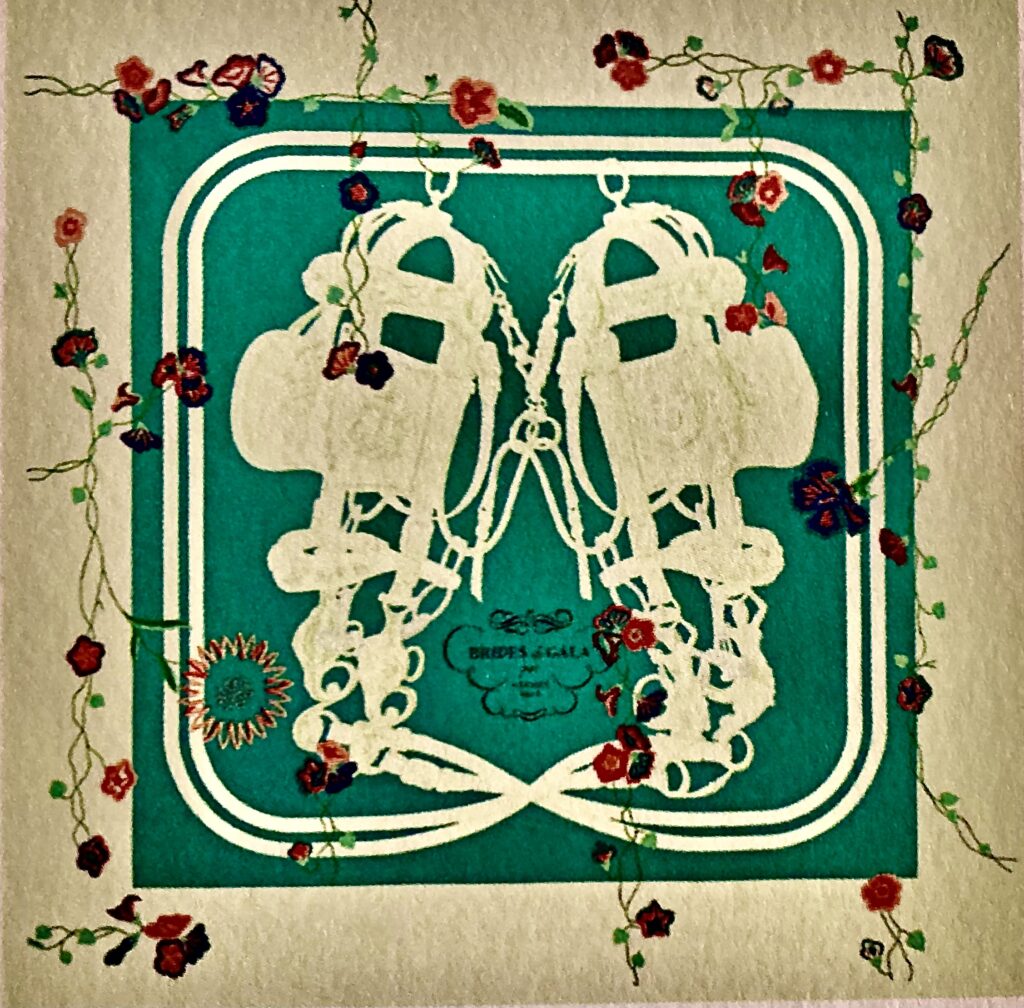
Brides de Gala Fleuries |
Grygkar’s witty side can be seen in a particularly humorous design in 1946, Pour éviter les accidents de voitures, restez chez vous—the text, that’s also the name of the scarf, is in the center of the scarf with scenes of voiture accidents all around the edges. “Throughout the 1940s these scarves (the Hermès scarves) proved an antidote to the harsh realities of war…”
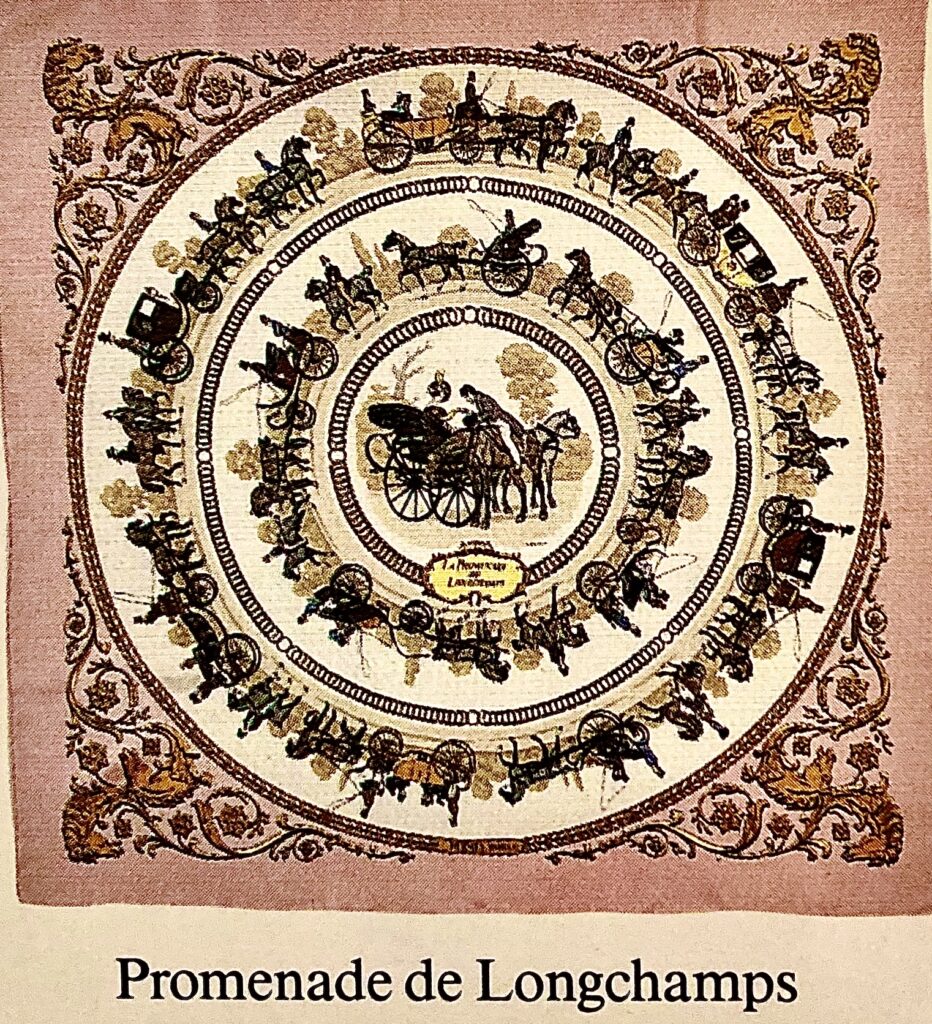
Promenade de Longchamps
Grygkar’s, Brides de Gala, (1957), motif is one of Hermès’ most iconic, popular, reinterpreted and reimagined designs— “Two ceremonial bridles from the second half of the 19th century face one another.” Within the design, you’ll find “the delicate chiseled decorations, coats of arms, foliage and mermaids, as well as the work of leather.”, quotes from the Hermès site. The bridles were originally made for the Emperor of Mexico—a drawing of the bridles was in Èmile’s collection. It brings together Hermès’ history as saddler and harness makers. Among the reimagined designs of the bridles are the carré, Fleuries, Love, Bayadere, Shadow, and Finesse. There’s even a, Brides de Gala Perforated, scarf—quite extraordinary.
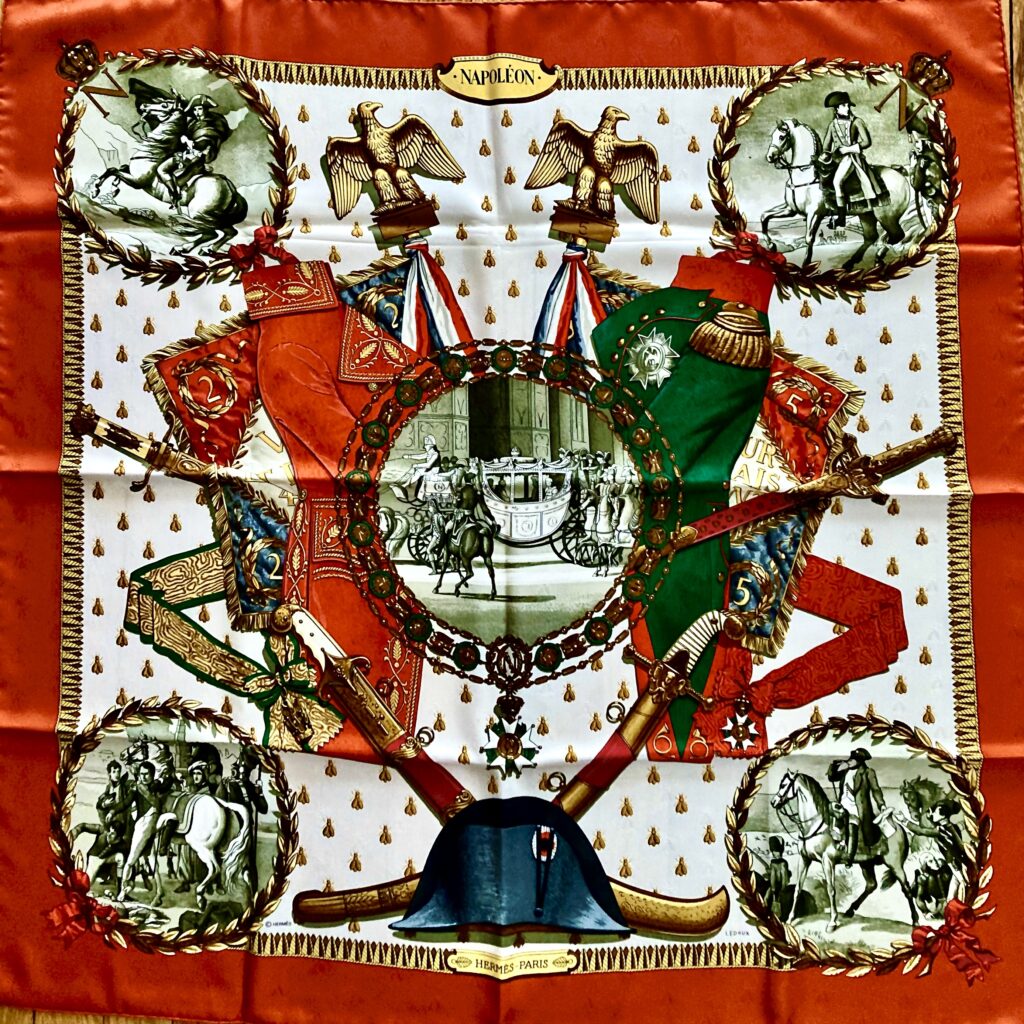
Napoléon
Philippe Ledoux, the other significant man in Hermès history, was an artist, book illustrator, and painter for the French Navy—historical and maritime themes, example, Marine et cavalerie, (1967).Quoting Karen Homer, “In 1947, Robert Dumas first commissioned Ledoux who went on to design 90 carrés, many with equestrian or naval scenes, and his ability to draw horses particularly impressed Dumas.”
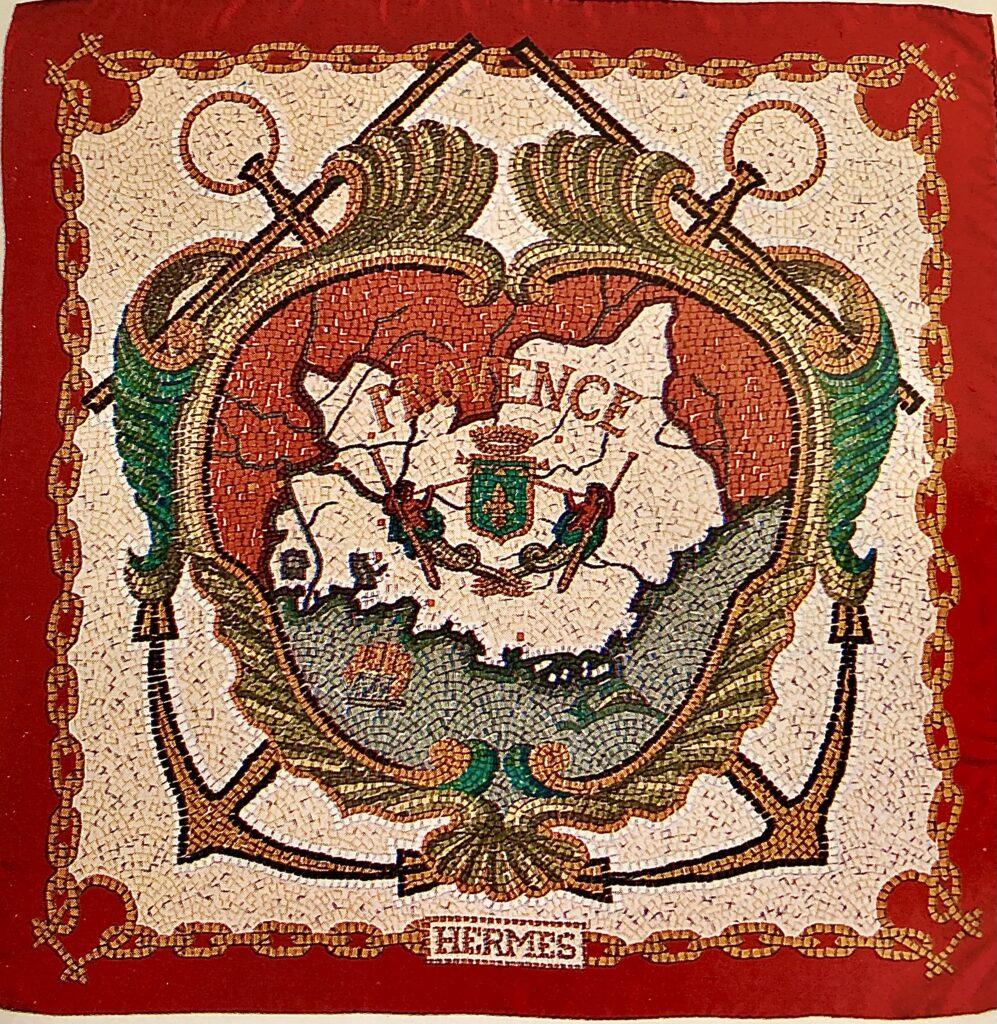
Provence Les Parures du Vent, 1930s. “The wind ornaments. Heed the racing wind. It’s coming from the figureheads that adorned the long-distance racing cars of the first half of the century.” Notice radiator caps are included in such a clever motif. Quote taken from a small Hermès publication. |
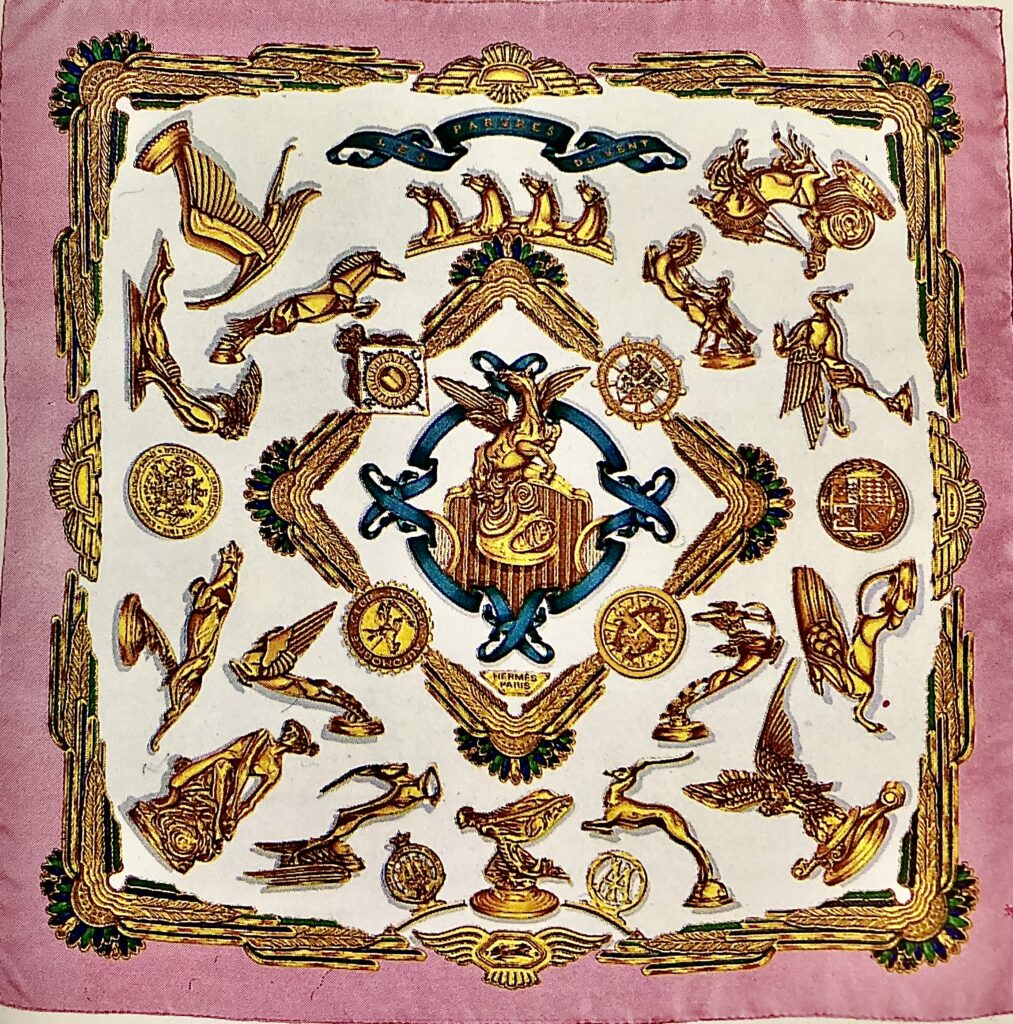
Les Parures du Vent, 1930s. “The wind ornaments. Heed the racing wind. It’s coming from the figureheads that adorned the long-distance racing cars of the first half of the century.” Notice radiator caps are included in such a clever motif. Quote taken from a small Hermès publication. |
Quoting from an Hermès publication about Ledoux’s design for the scarf, Promenade de Longchamps, (1965), “Ever since La Belle Epoque, the Longchamps racetrack in the Bois de Boulogne has figured socially in the life of elegant Parisians. And almost as glittering as the races was the Promenade de Longchamps, where resplendent carriages brought the beau monde to their beloved track.” In his design for the Napoléon scarf, (first appeaing in 1963), “History and art blend handsomely in this Empire design. The two sabres were used by Napoléon in his Egyptian battles. The coat on the left was part of his uniform.”, his chasseur à cheval. All of these Napoléon symbols, and more, on a background of bees, adorn the jacquard silk square.
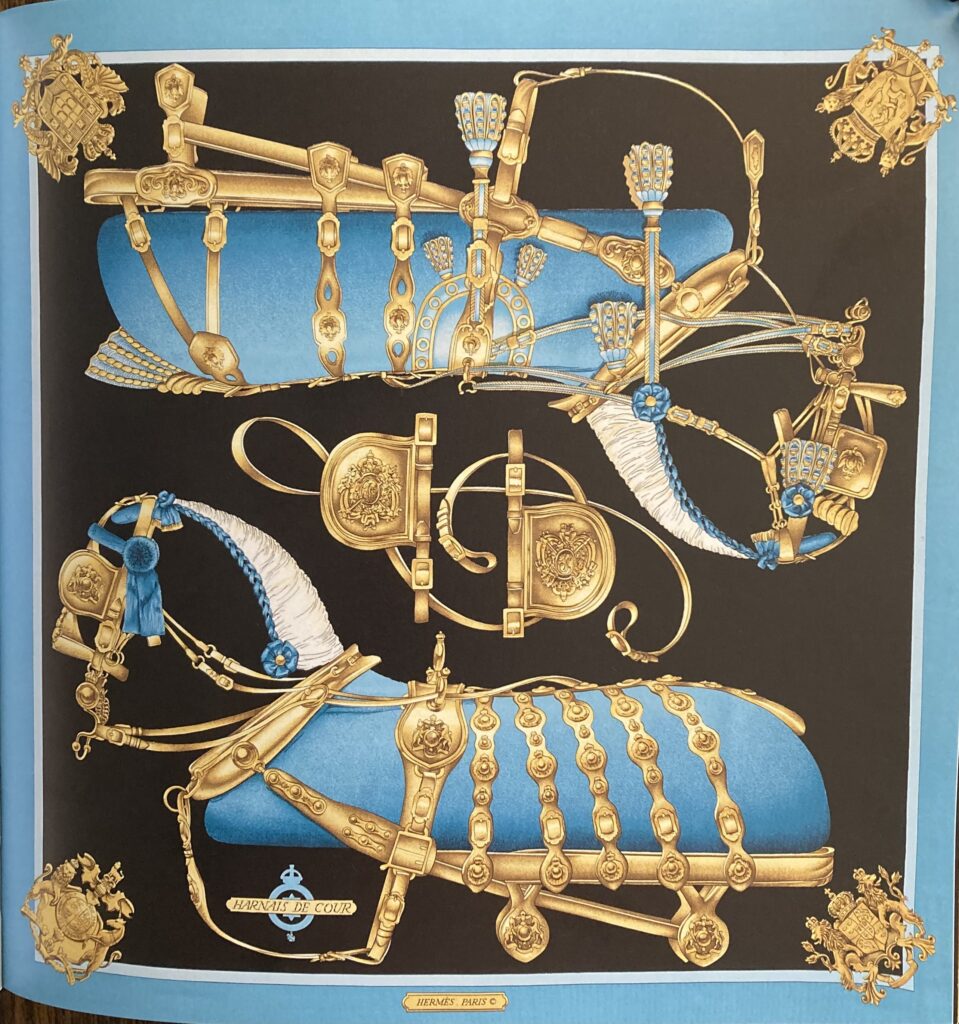
Harnais de Cour
Ledoux’s iconic scarf design, Harnais de Cour, has been reinterpreted many times. A description of the harnesses from the Hermès site, “This type of court harness was regularly used in France until the mid 19th century, and later reserved for sovereign courts and gala events. A team of master craftsmen would have worked on each impressive section of these luxurious objects, braiding mares with silk or velvet bands decorated with tassels and palace embroidery, and crafting saddle stitch leather, metal cockades and rosettes.”
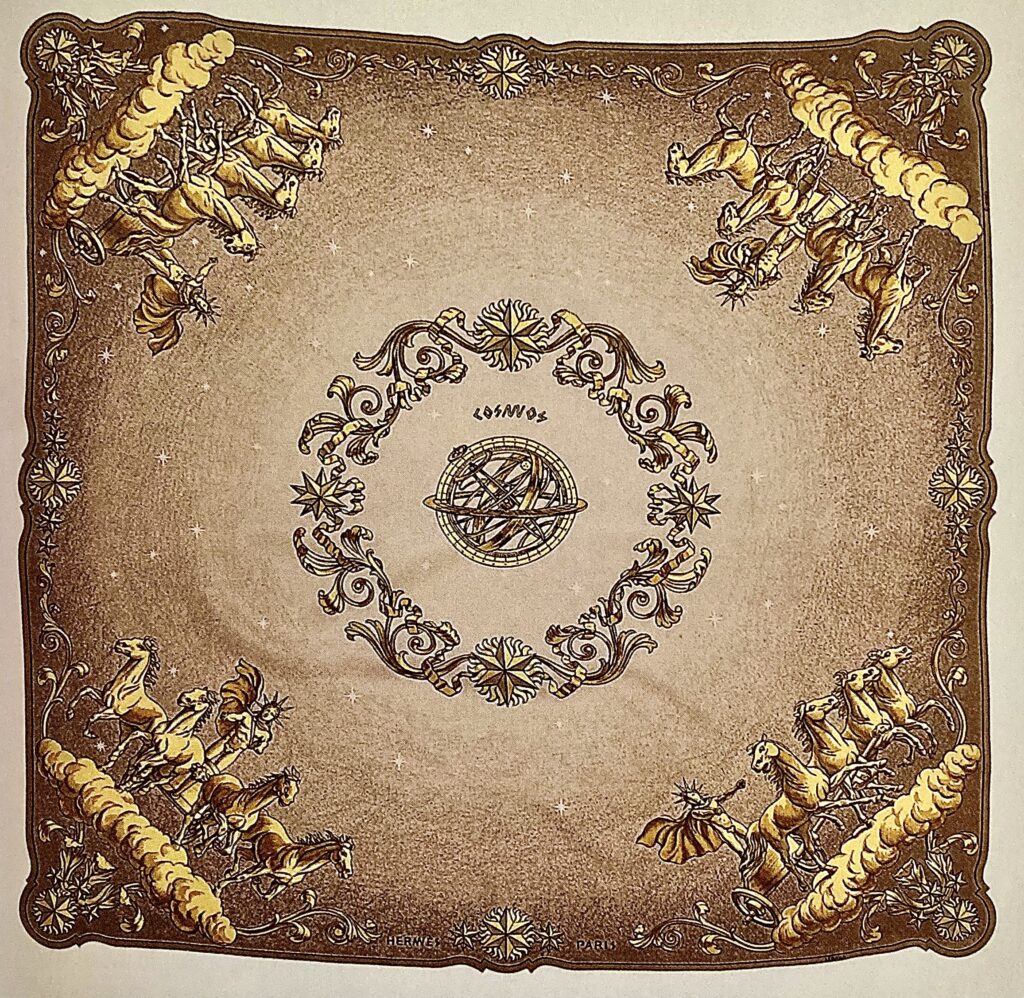
Cosmos, Philippe Ledoux.

Pop-Up Hermès!

Pop-Up Hermès!
Although, there are many, many designers of Hermès scarves, too many to name here, their stories and the inspiration behind each motif they create has something in it that’s interesting, thought provoking and beautiful.
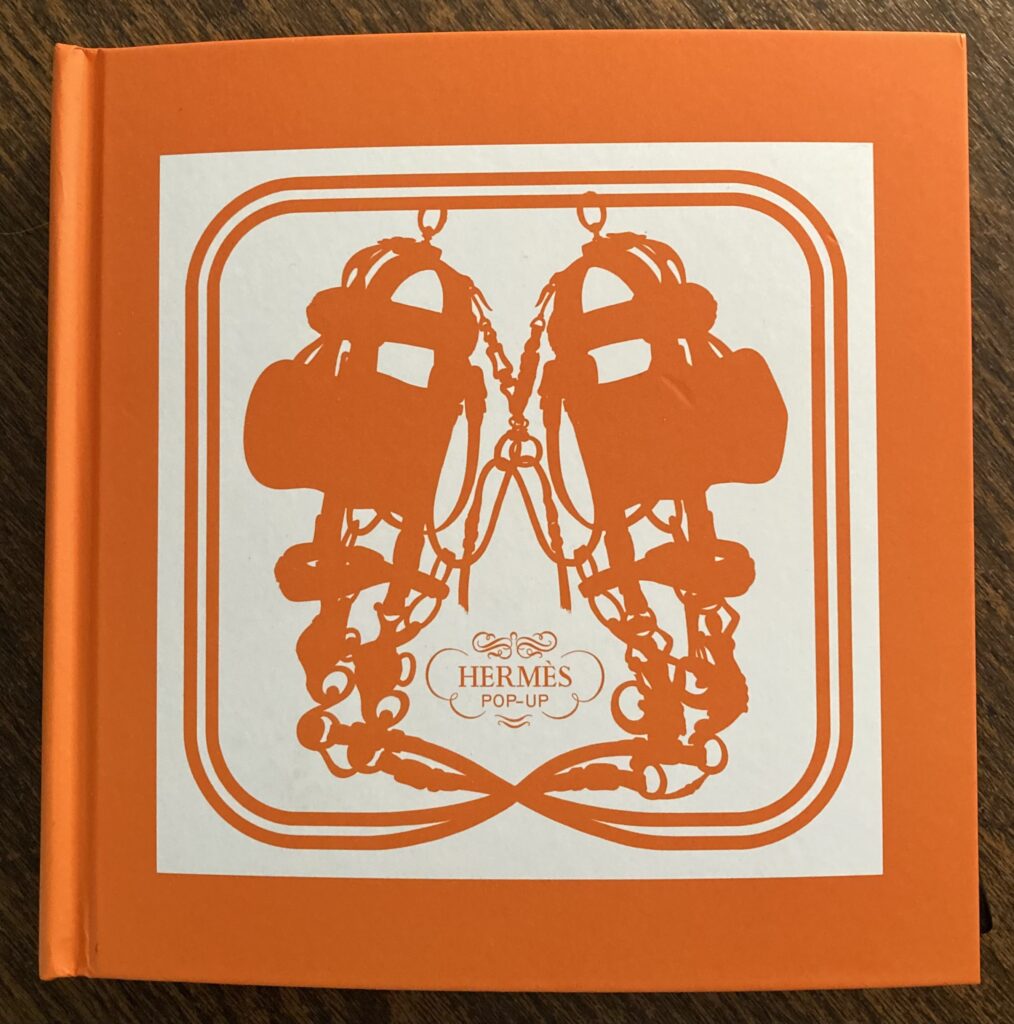
Brides de Gala image on the cover of the Hermès Pop-Up book. |
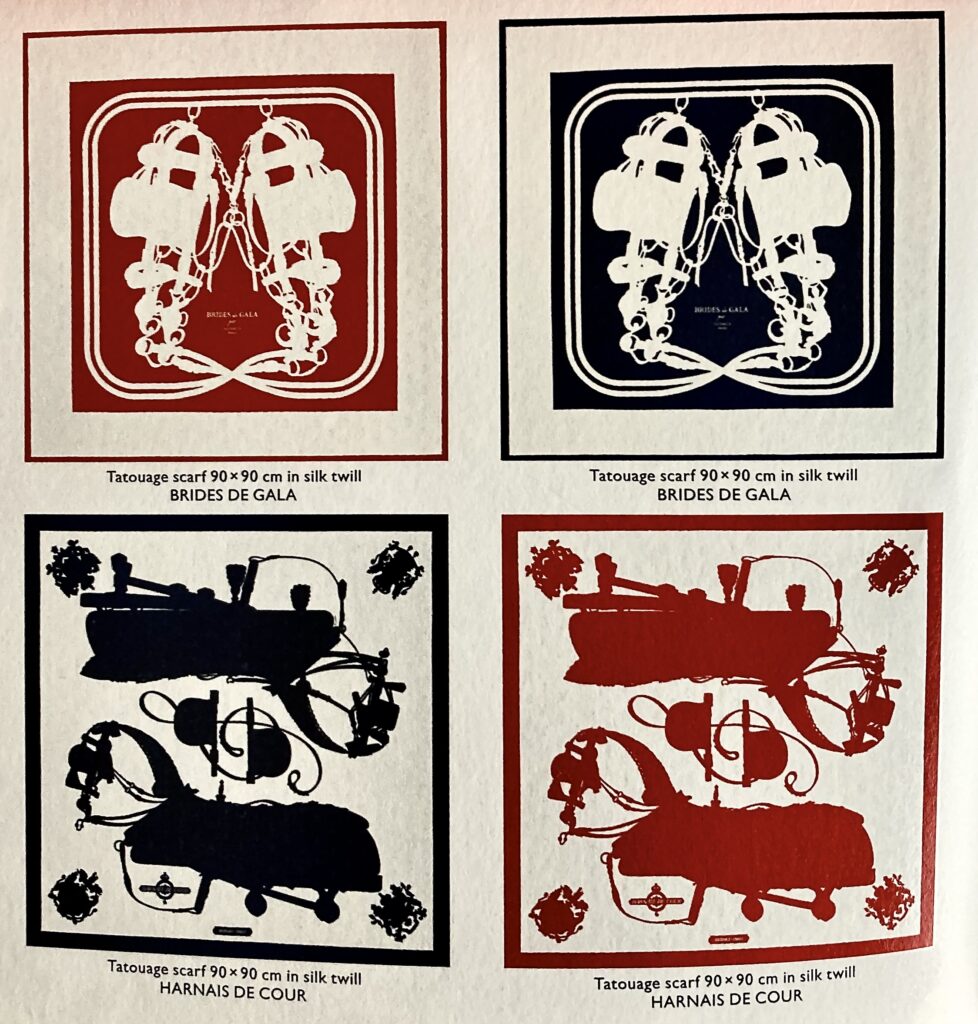
Brides de Gala and Harnais de Cour, imagined as Tatouages. |
The only American to design a scarf for Hermès is Kermit Oliver. His design, Faune et Flore du Texas, was a tribute to the Texas Sesquicentennial in 1986. I was living in San Antonio at the time. The name of the scarf tells you what you’ll find in the design—a collage of animals large and small, I love the longhorn and armadillo, plants familiar to those who know Texas, bluebonnet and cactus. Indeed, it’s a colorful visual display of Texas’ glory. The scarf was reissued with a few changes, but the big beautiful turkey remained in the center!

Faune et Flore du Texas |
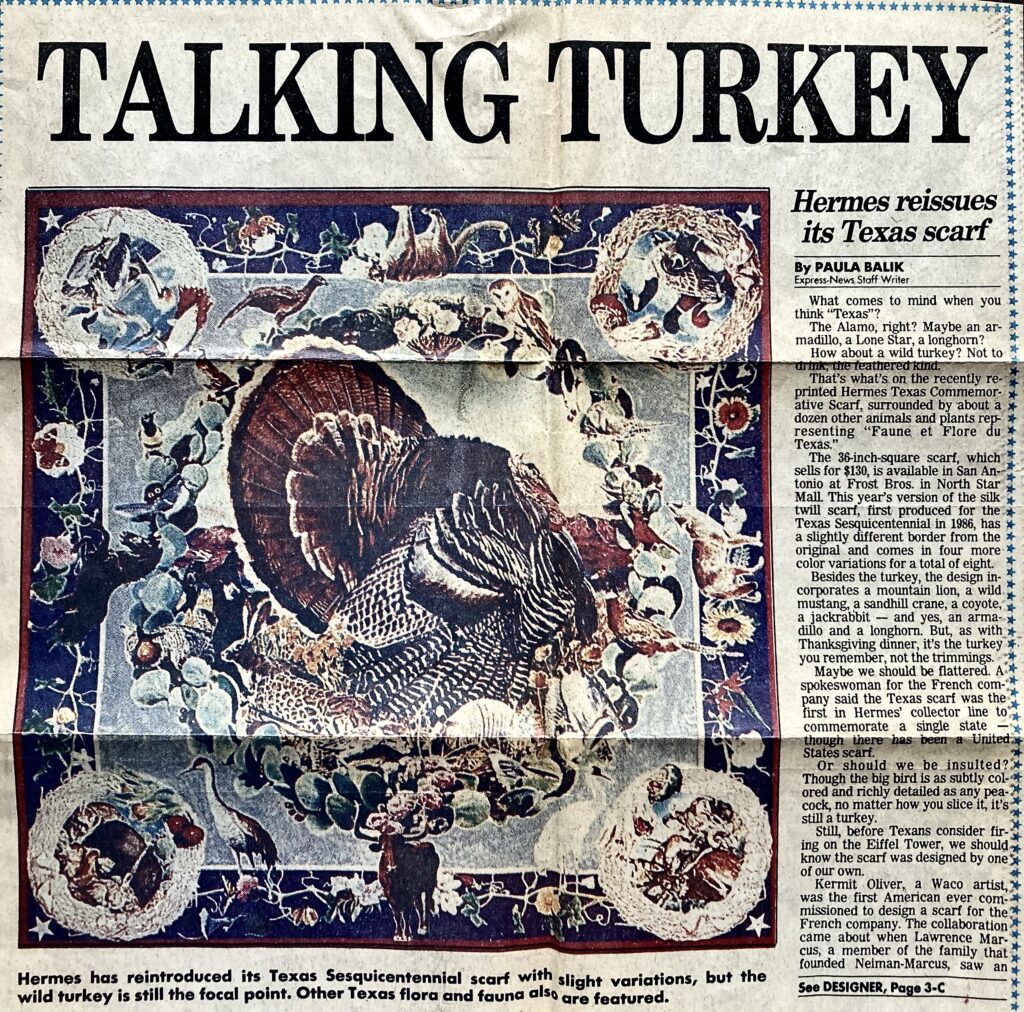
Article from a San Antonio newspaper. |

Reissued design of, Faune et Flore du Texas.
Oliver was born in Refugio, Texas (1943), his father was a cowboy on a cattle ranch. Kermit showed an early artistic talent drawing the cattle, horses, and the flora of south Texas. All of these elements are found in his Texas scarf. His his love of Texas and its heritage is right there on the silk square. He graduated in 1967 from Texas Southern University where he studied art—his artwork stood out as being something very special. Tried teaching at the university and the Art League of Houston, but found teaching was not his thing.

Imagerie, “…a world where warriors return from the wars and where madens walk small dogs.” Quote taken from a small Hermès publication.
Married in 1962, moved to Waco in 1984 where he took a job sorting mail at night in the Waco post office—worked there for thirty years, painting during the day. He had also worked for the postal service in Houston. This full time job allowed him to pursue his passion and support his family. He retired from the postal service in 2013.
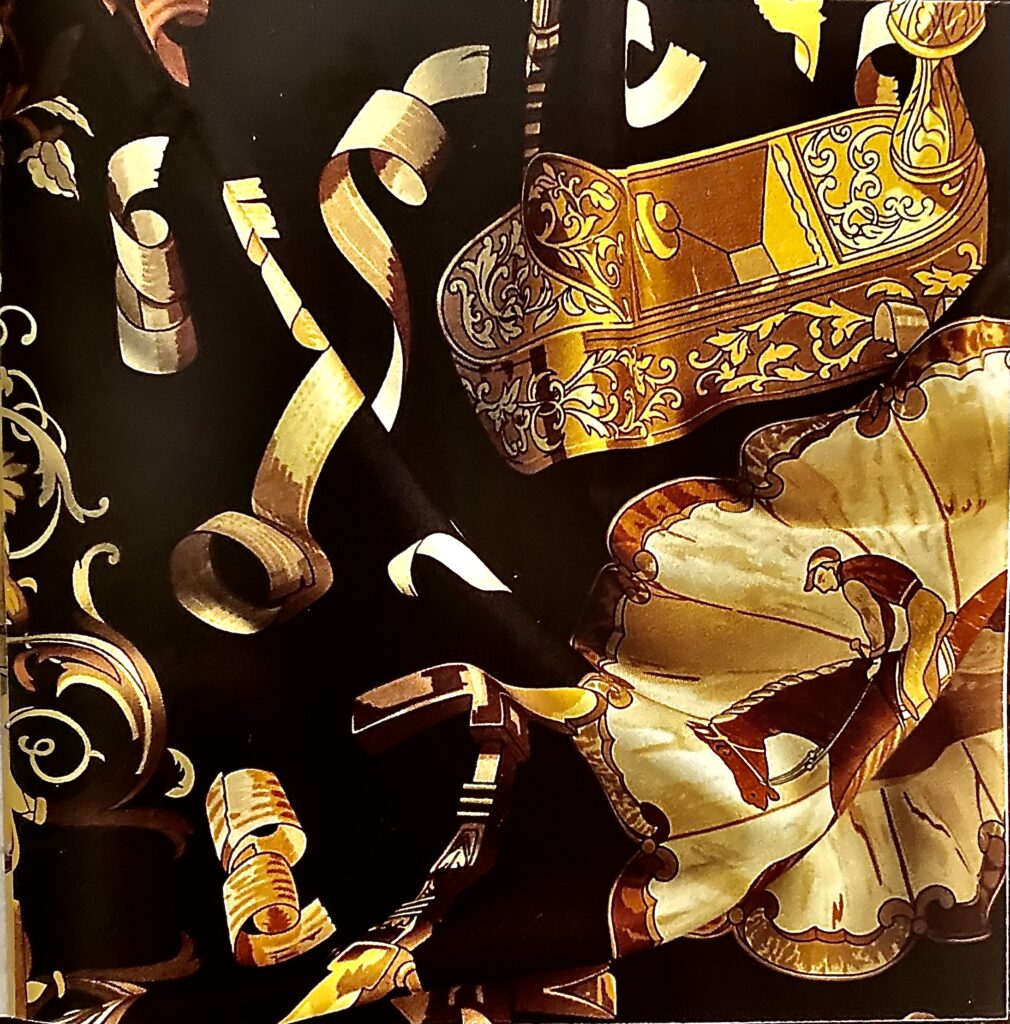
“…this scarf celebrates the cabinet maker through the tools…” The wood shavings on top of what is said to be a mahogany pedestal table–caught my eye. Quote taken from a small Hermès publication,
The time came in 1980 when the Hermès company was looking for an artist to design a scarf with a Southwestern theme. Lawrence Marcus, of Neiman Marcus department stores, knew just the person to recommend and introduced Oliver to Hermès. So began his association with Hermès. Oliver haș designed sixteen scarves for Hermès—the first being that of a Pawnee chief, Pani La Shar Pawnee. It was a great success.

Pani La Shar Pawnee
Kermit Oliver’s story is one I find inspiring and remarkable. This very private man revealed himself a bit in a conversation, on December 7, 2021, that he had with Michael Marks, who’s with Texas Standard, The National Daily News Show of Texas. You’ll find it online.
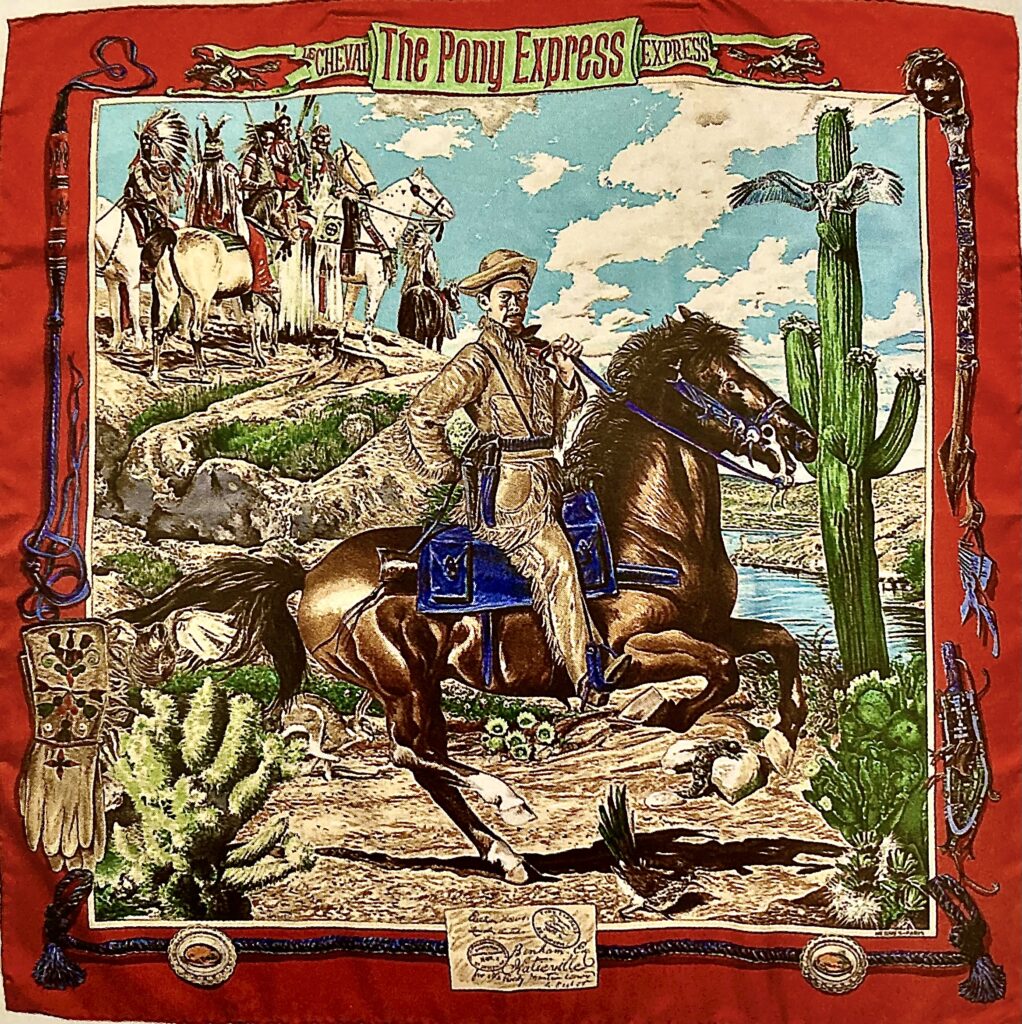
The Pony Express, Kermit Oliver. |
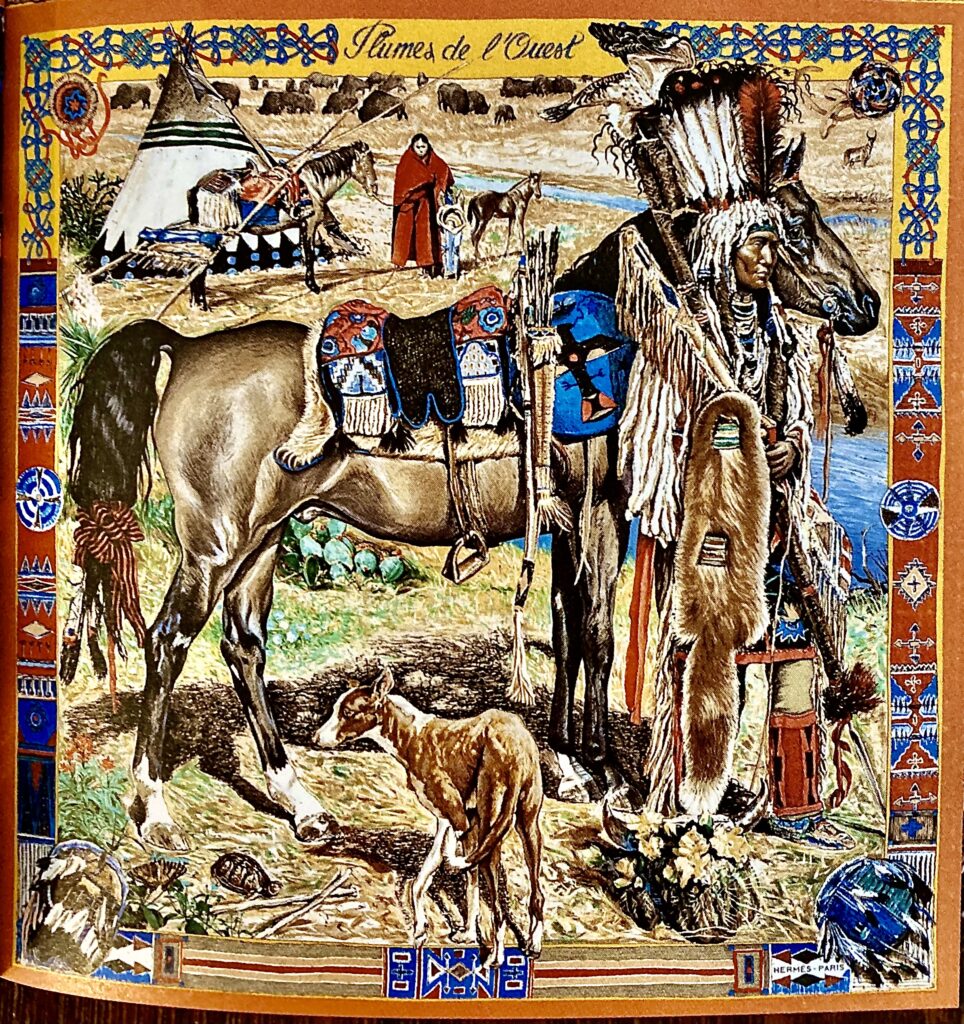
Plumes de l’Ouest, Kermit Oliver. |
My favorite cashmere shawl is, À Travers champs, (Through the fields), designed by Marie Bonnin. Its design is her interpretation of the village in the Auvergne region of France where she grew up—evoking valleys, country lanes, gardens, little houses with their sloping roofs, and mountainsides in a sort of maze arrangement. I was looking for something bright and cheerful. At first, the colors attracted me, and then when I learned the story behind the design it was obvious why I found it so appealing beyond the colors. My love of the French countryside was captured. Hermès designs always tell a story. Beyond the colors, you wonder, what is it about that scarf or shawl that draws you in? For some reason, it just does. Only you know for sure what it was that moved you.
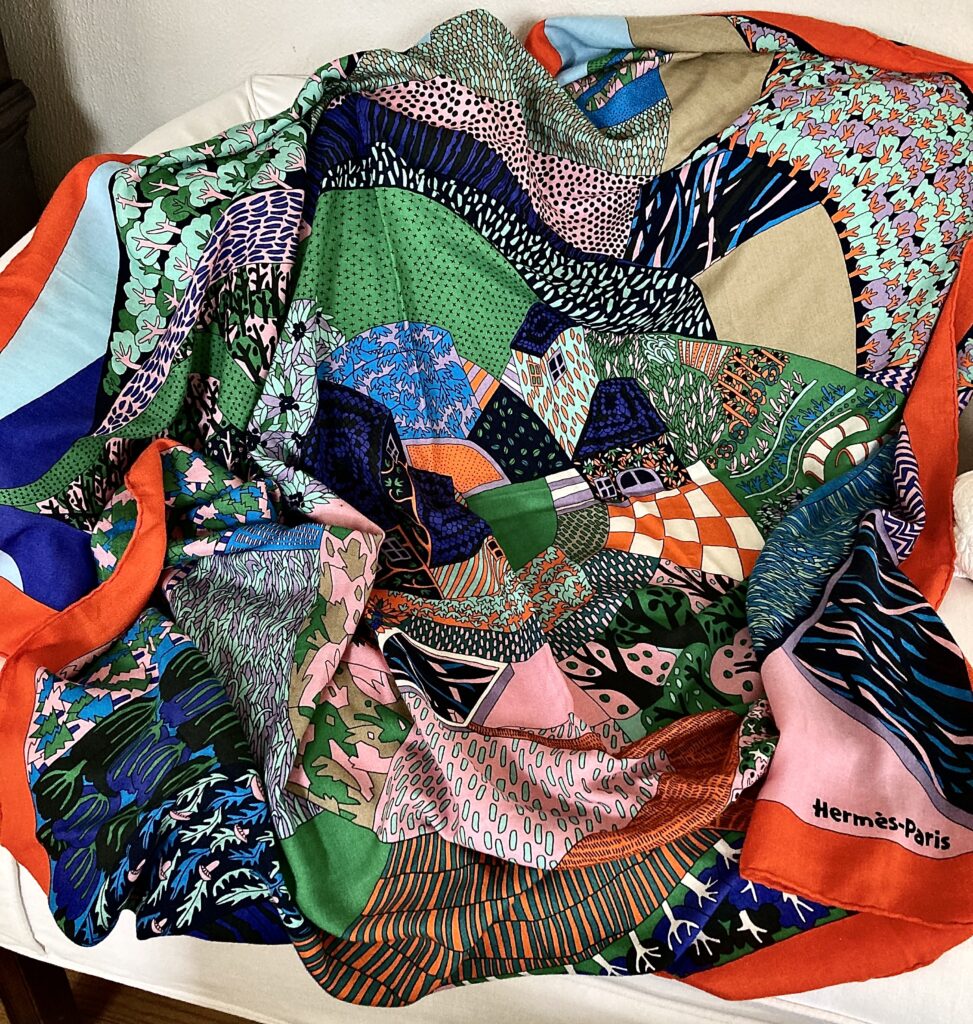
À Travers champs, shawl. |
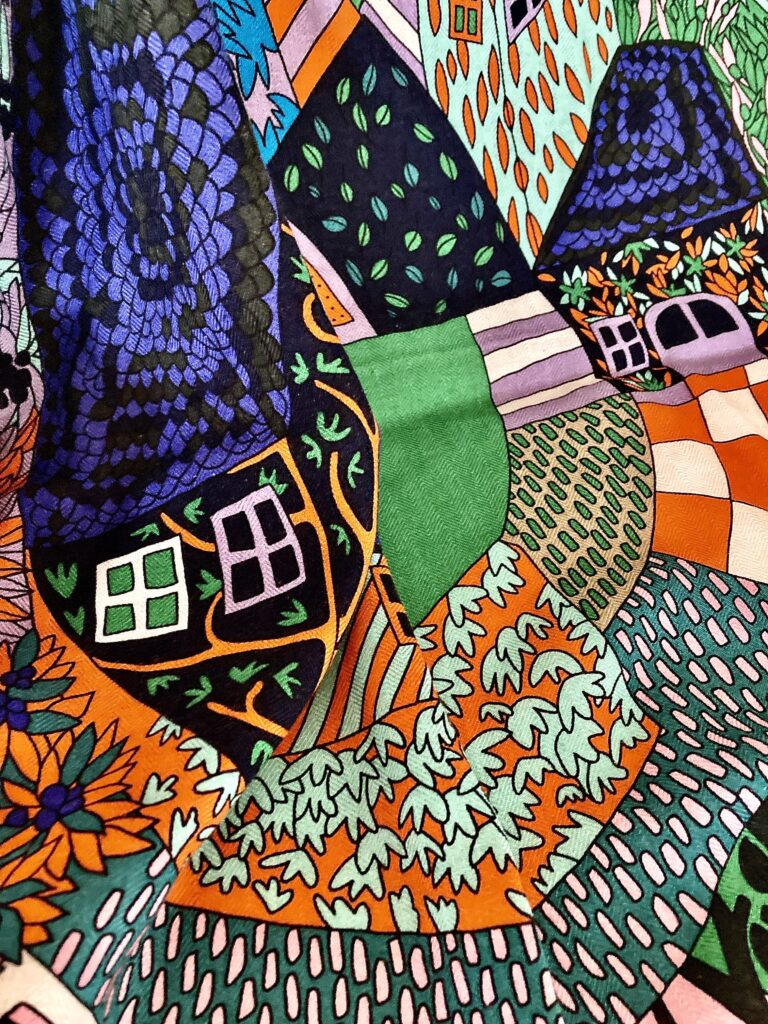
Closeup of, À Travers champs, shawl. |
Now, to the windows at 24, rue Faubourg-Saint-Honoré— remarkable displays for which Hermès is famous. Yet another way Hermès expresses their genius and remarkable creativity are these window displays. As you approach the flagship store your senses are alerted. The displays are evocative. Perhaps, some of you have seen them on your visit to Paris. Truly thought provoking were those displays created by Leïla Menchari.. It can be said, Menchari made the window displays legendary. Menchari’s drawings caught the attention of Annie Beaumel. In 1961 she invited Menchari to join the Hermès decorating team. Between 1978-2013 Menchari was the director of the window displays at the flagship store creating 136 displays. Scarves, Regina and Jouance are two of her designs.
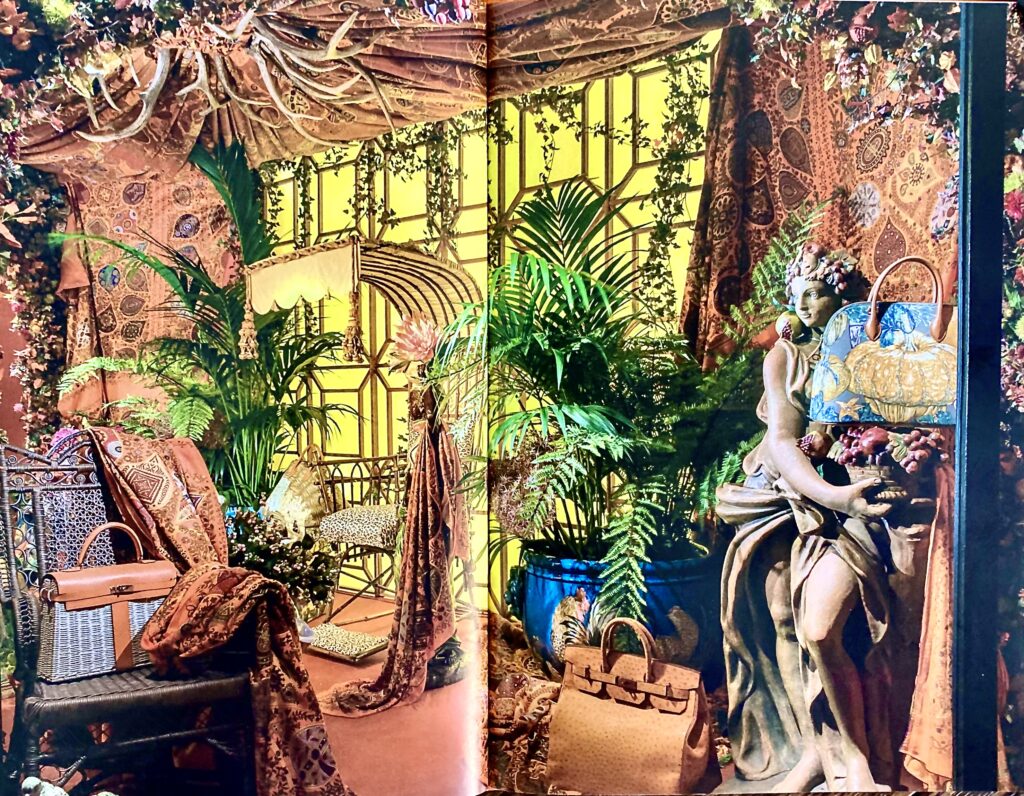
Menchari window display. Lucious…comes to mind as I look at this display.

Menchari window display. |
Menchari window display. |
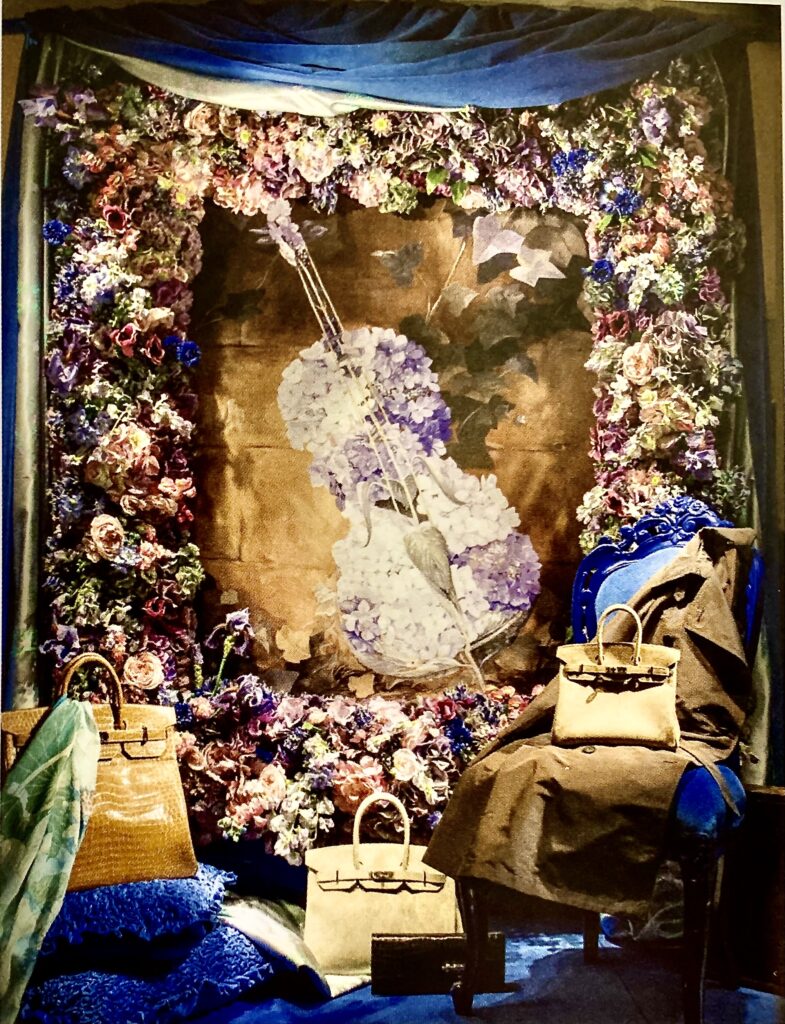
Menchari window display. A simply delicious display of flowers.
Menchari was trained in theatre set design. For, Vogue Arabia in 2017, she is quoted as saying, “When designing a scene, there must always be some mystery, because mystery is a springboard to dreams. Mystery is an invitation to fill the gaps left by the imagination.” Her displays awakened our visual senses combining vibrant or subtle colors and myriad textures. One cannot resit pausing and taking in what you’re seeing—perhaps discussing it with whomever you’re with. Somehow, handbags in the settings make sense. As I’ve said before, a story lies behind each carré de soir, so also there was a story within Leïla Menchari’s window displays. She was held in high regard by the Hermès family. Her office was in the headquarters until she was in her 80s. Born in Tunis 1927 and, sadly, died in April 2020, age 93, from COVID-19.

Regina, Leïla Menchari |

Leïla Menchari and Jean-Louis Dumas |
Quoting from the hermès.com site on the subject of “Creative Freedom”:
“The creations are the fruit of their creators’ curiosity and of their artisans’ exceptional know-how, and they achieve the house’s goal, namely to accompany customers in their everyday lives, across a diverse range of activities. Creating and crafting bespoke objects have been central to the story of Hermès since its origins…”
À bientôt
Quotes and Pictures:
The Hermès Scarf—History & Mystique, by Nadine Coleno, Thames and Hudson, publisher.
Hermès publications.
Little Book of HERMÈS, The Story of the iconic fashion house, by Karen Homer, published by Welbeck.








